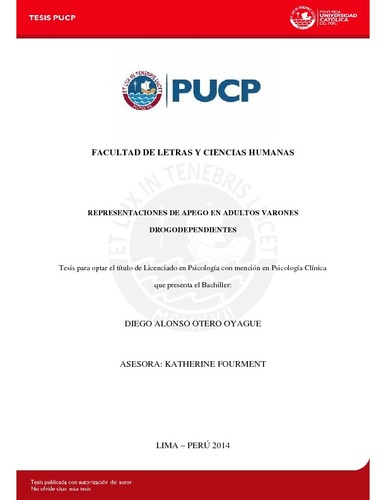| dc.contributor.advisor | Fourment Sifuentes, Katherine Gretel | es_ES |
| dc.contributor.author | Otero Oyague, Diego Alonso | es_ES |
| dc.date.accessioned | 2014-09-29T14:38:21Z | es_ES |
| dc.date.available | 2014-09-29T14:38:21Z | es_ES |
| dc.date.created | 2014 | es_ES |
| dc.date.issued | 2014-09-29 | es_ES |
| dc.identifier.uri | http://hdl.handle.net/20.500.12404/5601 | |
| dc.description.abstract | Representaciones de apego en adultos varones drogodependientes:
En la presente investigación se describen las representaciones mentales de apego de un grupo de 28 adultos hombres en recuperación por drogodependencia. Las edades de los participantes se encuentran entre los 23 y 59 años (M=36; DE=10.2). El total de los participantes reside en la ciudad de Lima, el 64% ha recibido educación superior y el 36% ha recibido educación secundaria. Se utiliza el autocuestionario de representaciones de apego para adultos “CaMir”. Tomando en cuenta las escalas de esta prueba, se realizaron dos contrastes de medias: el primero fue realizado con un grupo comparativo de supuestos normales y el segundo fue realizado tomando como referente el puntaje ideal para el prototipo ideal de apego seguro. En el primer contraste se encontraron diferencias significativas en todas las escalas del CaMir, mientras que en el segundo contraste también se encontraron diferencias significativas exceptuando las escalas B (Preocupación familiar) y K (Bloqueo de recuerdos). En líneas generales, las escalas relacionadas al prototipo de apego autónomo fueron comparativamente más bajas, y las escalas relacionadas a los prototipos: preocupado, desapegado, no resuelto y al medio de estructuración familiar, fueron comparativamente más altas. | es_ES |
| dc.description.abstract | Representations of attachment in drug dependent male adults:
This investigation describes the mental representations of attachment of a group of 28 male adults recovering from drug dependence. Participants ages fluctuate between 23 and 59 years (M=36; DS=10.2). All participantsive in the city of Lima, 64% has received college education and 36% has received high school education. For these purposes, we used the self-report questionnaire of attachment representations for adults “CaMir”. Two contrast medias resulted from the CaMir scales: the first one was carried out with a group of apparently normal individuals and the second one, using as reference the ideal score for the secure attachment prototype. In the first contrast, significant differences were found within all the CaMir scales, whereas in the second contrast, significant differences were also found, but not in scales B (family awareness) and K (memory block). In general, scales related to the autonomous attachment prototype were comparatively lower, and the scales related to the preoccupied prototype, dismissing prototype, non-result prototype and to the family structure, were higher. | es_ES |
| dc.language.iso | spa | es_ES |
| dc.publisher | Pontificia Universidad Católica del Perú | es_ES |
| dc.rights | Atribución-NoComercial-SinDerivadas 2.5 Perú | * |
| dc.rights | info:eu-repo/semantics/openAccess | es_ES |
| dc.rights.uri | http://creativecommons.org/licenses/by-nc-nd/2.5/pe/ | * |
| dc.subject | Apego. | es_ES |
| dc.subject | Drogadicción. | es_ES |
| dc.title | Representaciones de apego en adultos varones drogodependientes | es_ES |
| dc.type | info:eu-repo/semantics/bachelorThesis | es_ES |
| thesis.degree.name | Licenciado en Psicología Clínica | es_ES |
| thesis.degree.level | Título Profesional | es_ES |
| thesis.degree.grantor | Pontificia Universidad Católica del Perú. Facultad de Letras y Ciencias Humanas. | es_ES |
| thesis.degree.discipline | Psicología Clínica | es_ES |
| renati.discipline | 313026 | es_ES |
| renati.level | https://purl.org/pe-repo/renati/level#tituloProfesional | es_ES |
| renati.type | http://purl.org/pe-repo/renati/type#tesis | es_ES |
| dc.publisher.country | PE | es_ES |
| dc.subject.ocde | https://purl.org/pe-repo/ocde/ford#5.01.00 | es_ES |






